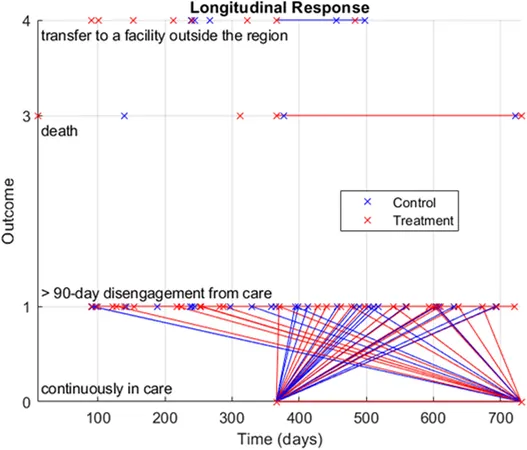
Groundbreaking Findings on HIV Interventions in Kenya Reveal Surprising Age-Specific Efficacy!
2024-11-09
Author: Siti
Introduction
In the fight against HIV/AIDS, recent research sheds light on the effectiveness of social-network interventions, particularly among older populations in Kenya. As the country grapples with alarming HIV rates—particularly in Homa Bay County, where prevalence is a staggering 4.5 times the national average—engaging patients in ongoing care becomes paramount.
Kenya’s National AIDS Strategic Plan
Kenya’s National AIDS Strategic Plan aims to enhance engagement in care, minimizing interruptions and deaths while boosting the initiation of antiretroviral therapy (ART). International aid programs, such as the well-known PEPFAR initiative, have reportedly saved millions of lives, but challenges remain in maintaining patient commitment to treatment, crucial for reducing the transmission of the virus and preventing ART resistance.
Age Disparities in Treatment
Interestingly, age disparities play a significant role in HIV transmission dynamics, treatment adherence, and stigma surrounding the disease. While younger populations tend to bear a heavier burden in many regions, this study highlights a rather surprising trend regarding the older generation. In Kenya, young men aged 20-29 and women aged 15-24 are among those most affected, yet the research indicates that social-network interventions are uniquely poised to engage older patients more effectively than previously recognized.
Research Methodology
Researchers conducted a pioneering analysis using a Microclinic social network-based randomized controlled trial on Mfangano Island—a community grappling with both high HIV prevalence and poverty, where the majority rely on subsistence farming. Groups were formed with 5-10 individuals, providing social support and resources to patients living with HIV, facilitating access to regular care and treatment adherence.
Research Findings
The findings revealed that a staggering 72% of participants in the intervention group engaged actively in these micro-clinics, and a significant positive correlation was observed between the age of participants and the effectiveness of the intervention. The data from the statistical analysis illuminated that older age groups experienced improved treatment outcomes when engaging with the Microclinic intervention.
Implications for Future HIV Treatment
What does this mean for the future of HIV treatment? For patients over 50, extended time in treatment markedly improved their health results, while younger groups showed mixed or even negative results, which warrants further exploration. The emphasis on combating stigma and fostering open communication through these microclimates demonstrates the crucial role of support systems—not just from healthcare providers, but from friends and family networks.
Policy Recommendations
However, the implications extend beyond just treatment; they call for a reevaluation of current HIV strategies. Policymakers and health officials are urged to implement age-sensitive approaches that cater to different demographics rather than relying on generalized methods.
Innovative Models for Healthcare
Amid fluctuating funding and logistical challenges in healthcare systems, such innovative models like the Microclinic social network intervention offer bright prospects for sustaining engagement in HIV care. The results from this study stress the necessity for targeted interventions aimed at different age groups and a clear focus on addressing the specific barriers to engagement for older populations.
Conclusion
Ultimately, as researchers and healthcare workers strive to amass comprehensive data, the overarching goal remains the same: to minimize the impact of HIV/AIDS across all demographics while maximizing the effectiveness and accessibility of care. The findings from Kenya not only promise to change the narrative for older individuals living with HIV but may also spark transformative approaches in HIV treatment globally.
Call to Action
Is your community adequately addressing the needs of older individuals living with HIV? Discover more about how tailored interventions can transform lives and save billions in healthcare costs!
 Brasil (PT)
Brasil (PT)
 Canada (EN)
Canada (EN)
 Chile (ES)
Chile (ES)
 Česko (CS)
Česko (CS)
 대한민국 (KO)
대한민국 (KO)
 España (ES)
España (ES)
 France (FR)
France (FR)
 Hong Kong (EN)
Hong Kong (EN)
 Italia (IT)
Italia (IT)
 日本 (JA)
日本 (JA)
 Magyarország (HU)
Magyarország (HU)
 Norge (NO)
Norge (NO)
 Polska (PL)
Polska (PL)
 Schweiz (DE)
Schweiz (DE)
 Singapore (EN)
Singapore (EN)
 Sverige (SV)
Sverige (SV)
 Suomi (FI)
Suomi (FI)
 Türkiye (TR)
Türkiye (TR)
 الإمارات العربية المتحدة (AR)
الإمارات العربية المتحدة (AR)